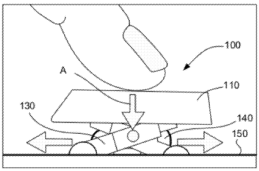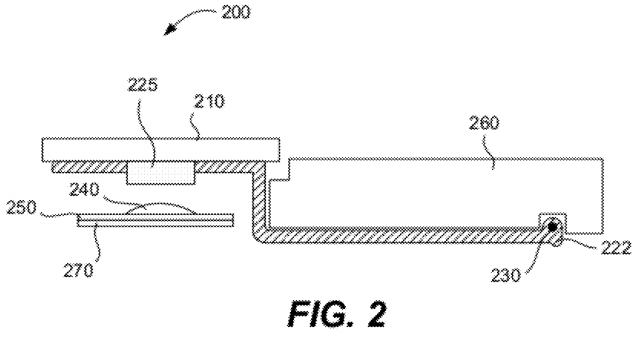An interesting patent application from Apple has just been made public, and it looks like one that may actually get some use (and seems like a “legitimate” patent, to boot). It has to do with a new mechanism for keyboard keys, one that loses much of the depth necessary in mechanical or scissor-switch mechanisms, yet purportedly doesn’t sacrifice the tactile feel we all crave from a keyboard.
 Most compact keyboards use a scissor-switch mechanism, which is generally a hinged affair with a scissor-like attachment between struts that offer resistance, and push the key back upwards. They’re not quite as big and comfortable (and clicky) as mechanical keyboards, which have a larger spring mechanism, but they suffice if they’re built well. In a mechanical keyboard, the key may travel 4 or 5 millimeters up and down. In a scissor-switch key, it might go 1.5-2.0mm.
Most compact keyboards use a scissor-switch mechanism, which is generally a hinged affair with a scissor-like attachment between struts that offer resistance, and push the key back upwards. They’re not quite as big and comfortable (and clicky) as mechanical keyboards, which have a larger spring mechanism, but they suffice if they’re built well. In a mechanical keyboard, the key may travel 4 or 5 millimeters up and down. In a scissor-switch key, it might go 1.5-2.0mm.
Apple proposes a totally new type of keydown mechanism — one that does without the symmetrical-spring design we’ve been using for so long. Instead of a couple hinged arms pushing directly against the key-pressing pressure, the key would be the end of a longer tongue of metal attached firmly somewhat further up the keyboard. When you press down on the key, the metal bends and hits the mechanical sensor that sends a keydown signal to the computer. The result? The key now travels as little as 0.2mm.
Now, naturally, everyone will (and should) object that such a short key travel can’t possibly be comfortable. Apple is aware of this:
The skilled artisan will appreciate that it is desirable to make the keyboard (and computing device) thinner, but users still want the tactile feel to which users are accustomed. It is desirable for the keys to have some “bounce-back” or “snappy” feel. As can be appreciated by the skilled artisan, substantially flat keyboards, such as membrane keyboards, do not provide the tactile feel that is desirable for a keyboard. Similarly, simply reducing the travel of a typical rubber dome scissor-switch keyboard also reduces the tactile or “snappy” feel that a conventional dome-switch keyboard provides.
But they claim that by using a metal collapsing dome (the part that must be pushed down fully to cause the switch to activate) and an “elastomeric spacer”, combined with the natural resistance of the metal lever the user bending, they are able to provide a comfortable tactile experience while still losing a millimeter or two off the depth.
Then there’s the business of making sure they can fit all these metal levers next to each other in a keyboard configuration, which they seem to have nailed down. All told, it looks like quite a brilliant design. But will we see it in practice soon?
The patent was filed for in August of 2010, so it’s not like they just thought this up yesterday — and the MacBook Air’s design hasn’t changed significantly since it came out. It might be due. But it’s also possible that this design was filed, tested, and found wanting. Even the best designs can fail in the real world; perhaps no metal was suitable or inexpensive enough for the lever construction. Or maybe they tended to fail far earlier than existing keyboards.
We’re expecting a serious makeover for the Air and MacBook Pro lines this year, and this could very well be one of the features. But until it’s announced by Apple (or leaked by an unscrupulous supplier), it’s still just pie in the sky.
[via Apple Insider]
